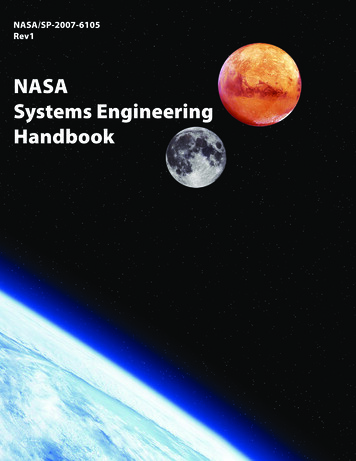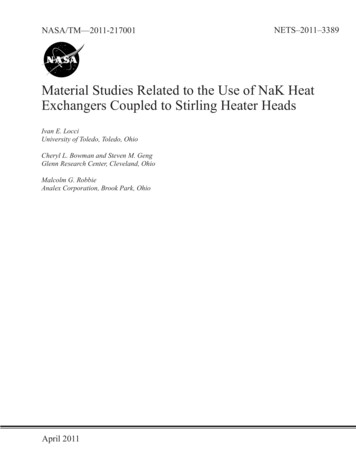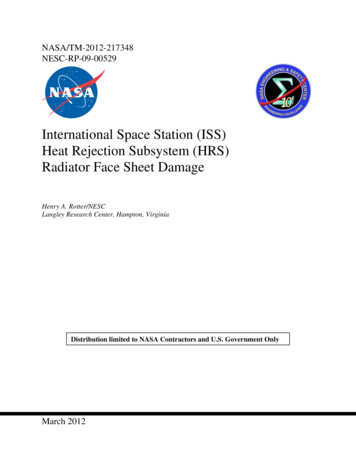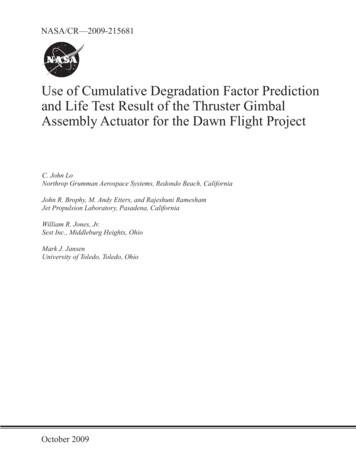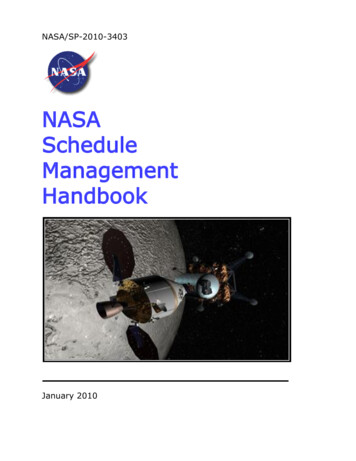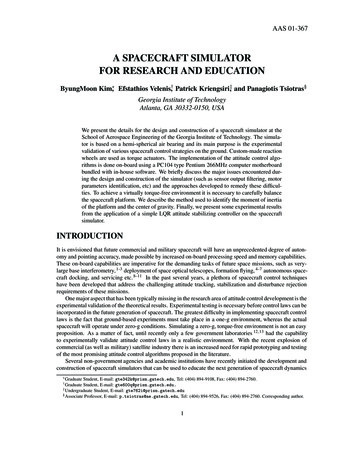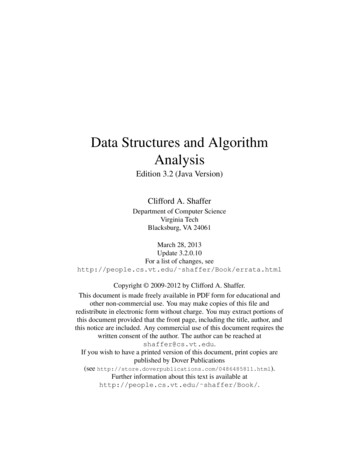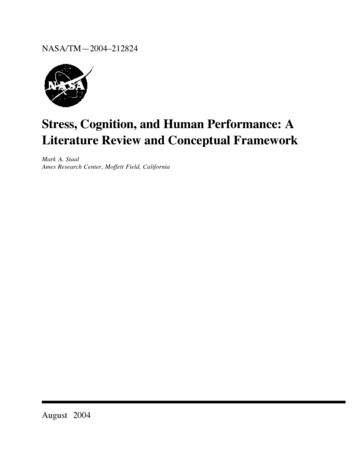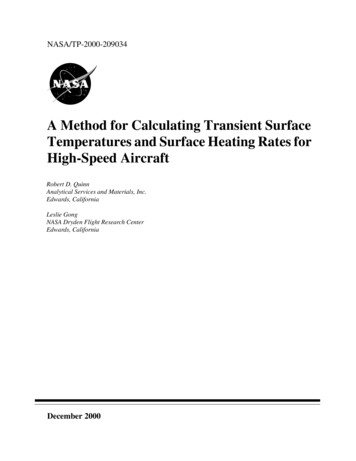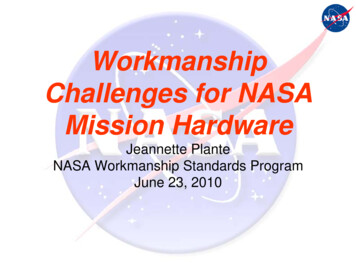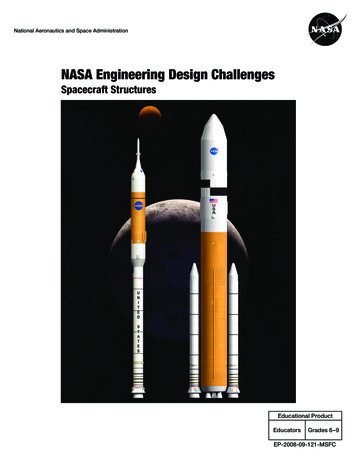
Transcription
National Aeronautics and Space AdministrationNASA Engineering Design ChallengesSpacecraft StructuresEducational ProductEducatorsGrades 6–9EP-2008-09-121-MSFC
Cover Illustration:NASA Ares I and Ares V Launch VehiclesNASA artist conceptions.
NASA Engineering Design Challenge: Spacecraft Structures 2007 – iTable of Contents1. Overview.12. How to Use This Guide.33. National Science Education Standards.44. Math Connections.65. Thinking Skills.76. BackgroundThe Ares Launch Vehicles. 8Spacecraft Structures. 97. Teacher PreparationRequired Materials.13Build the Launcher. 15Build the Rockets. 17Practice Launching a Rocket. 17Prepare the Materials for the Classroom. 18Teaching Strategies for an Engineering Design Challenge. 19Helping Students Understand the Design Process. 218. Classroom SessionsSession 1: Introducing the Challenge and Getting Started. 22Session 2: Design 1. 27Session 3 and 4: Designs 2, 3, 4, and 5. 31Session 5: Construct a Storyboard/Poster. 34Session 6: Student Presentations. 36Linking Design Strategies and Observations to Science Concepts. 379. Modifications and Extensions. 4410. Resources. 4611. Masters. 49Flier for ParentsHandouts/TransparenciesRecording Sheets
ii – NASA Engineering Design Challenge: Spacecraft Structures 2007*The Ares Engineering Design Challenges use Traditional U.S. units of measureas the standard. Metric units follow in (parenthesis). In cases when a givenformula is traditionally calculated in metric units, for mathematical correctness,it is presented in that manner.NOTE: The Ares vehicles are a very preliminary configuration and will be subjectto change as the design progresses.AuthorsNick Haddad, TERCHarold McWilliams, TERCPaul Wagoner, TERCSubject Matter Experts & ReviewersBob Bender: MSFC, Spacecraft & Vehicle Systems Department, QUALISJeff Finckenor: MSFC, Spacecraft & Vehicle Systems Department, NASAKristy Hill: MSFC, Academic Affairs Office, WILL Technology Inc.Bill Pannell: MSFC, Spacecraft & Vehicle Systems Department, NASATwila Schneider: MSFC, Ares Projects Office, Schafer CorporationDesign and LayoutSandra Schafer: Schafer LaCasse Design, Somerville, MAGraphicsTed Allbritton: MSFC, UNITeS Technical Publications & Illustrations, TRAXMelissa Higdon: MSFC, UNITeS Technical Publications & Illustrations, TRAXJennie Mitchell: MSFC, UNITeS Technical Publications & Illustrations, TRAXAres I and VNASA artist conceptionsEditorRegina Garson: MSFC, Ares Projects Office, UNITeSNASA explores for answers that power our future.www.nasa.gov
NASA Engineering Design Challenge: Spacecraft Structures 2007 – 1NASA Engineering DesignChallengesSpacecraft Structures1. OverviewSpace TransportationNASA Engineers at Marshall Space Flight Center, along with their partners atother NASA centers, and in private industry, are designing and beginning todevelop the next generation of spacecraft to transport cargo, equipment, andhuman explorers to space. These vehicles are part of the Constellation Program,which is carrying out a bold vision of human space exploration. The programincludes a crew exploration vehicle and the spacecraft to carry the crew to theMoon and later to Mars. The NASA Authorization Act of 2005 directs NASA toestablish a program to develop a sustained human presence on the Moon, whichwill serve as a stepping stone to further exploration of Mars and other destinations. This design challenge focuses on the Ares family of rockets, which willreplace the Space Shuttle in the task of putting people, satellites, and scientificexperiments into space.Figure 1.1. Thruststructure model.Connect to Engineering and ScienceThe Engineering Design Challenges connect students with the work of NASAengineers by engaging them in similar design challenges of their own. With somesimple and inexpensive materials, you, the teacher, can lead an exciting unit thatfocuses on a specific problem that NASA engineers must solve and the processthey use to solve it. In the classroom, students design, build, test, and revisetheir own solutions to problems that share fundamental science andengineering issues with the challenges facing NASA engineers.The Design ChallengeYou will present students with a challenge: Build a model thrust structure (theportion of the structure that attaches the engine to the rest of the spacecraft)that is as light as possible, yet, strong enough to withstand the load of a “launchto orbit” three times. See Figure 1.1. Students first determine the amount offorce needed to launch a model rocket to 3.3 feet (1 meter), which representslow Earth orbit. Then they design, build, and test their own structure designs.They revise their designs over several design sessions, trying to maintain orincrease the strength and reduce the weight of their structure. They documenttheir designs with sketches and written descriptions. As a culmination, studentscompile their results into a poster and present them to the class.Figure 1.2. Example launchtesting station.
2 – NASA Engineering Design Challenge: Spacecraft Structures 2007MaterialsYou will need a few simple and inexpensive materials: Craft sticks.Dowels.Glue guns and hot-melt glue.Corrugated cardboard.35 mm film canisters.1-liter soda bottles.2-liter soda bottles.25-50 pounds (11-23 kilograms) of sand. A sturdy cloth bag to hold the sand.Brass tubing.Package sealing tape about 2 inches wide.4-ounce paper cups.Time RequiredThe design challenge can be carried out in six 45-minute class periods, but youcould easily extend it for twice that length of time. We provide some ideas forextensions at the end of the guide.You will need to invest 4-8 hours gathering the materials, building the test stand,trying out your own designs, reading the guide, and preparing the classroom.Value to StudentsThese activities help students achieve national goals in science, math, and thinking skills. In the pilot testing of the design challenge, students embraced thedesign challenge with excitement. This activity will provide your students theopportunity to solve a challenge based on a real-world problem that is part ofthe space program and to use creativity, cleverness, and scientific knowledgein doing so. During these activities, students will have many opportunities tolearn about forces, structures, and energy transfer. The culminating activity givesstudents an opportunity to develop their presentation and communication skills.Student Research OpportunitiesThe "Resources" section of this guide includes many web sites where studentscan obtain additional information.Parent InvolvementThe "Masters" section of this guide includes a reproducible flier to send home toinform parents about the activity. It includes suggested activities students andparents can do at home together.SafetyThese activities meet accepted standards for laboratory science safety.
NASA Engineering Design Challenge: Spacecraft Structures 2007 – 32. How to Use This guideThis guide is divided into several sections: National Science Education Standards.Math Connections.Thinking Skills.Background Material.Preparation for the Challenge.Day-by-day Procedures.Extensions.Resources.Masters.National StandardsIf you have questions about how this activity supports the National ScienceEducation Standards, Math Connections, or Thinking Skills, read those sectionsfirst. Otherwise, refer to those sections only as you need them.Suggested Order of ReadingFirst, skim through the entire guide to see what is included.Next, read through the “Classroom Sessions.” Give special attention to the lastpart, “Linking Design Strategies and Observations to Science Concepts,” onPage 37. This gives explicit suggestions on how to help students understandthe science in their designs. Review this section again after you start classroomwork with your students.Be sure to read the last two sections in the “Teacher Preparation” section:“Teaching Strategies for an Engineering Design Challenge,” on Page 19, and“Helping Students Understand the Design Process,” on Page 21. These will helpyou understand what is distinctive about an Engineering Design Challenge andhow your students can get the most out of it.When you understand the session-by-session flow and the pedagogicalapproach on which it is based, read the “Background” section. This will provideyou with information you will want to have in mind to “set the stage” for studentsand to link their classroom work with the work of NASA engineers. It focuses onone of the challenges faced by NASA engineers in developing a reusable launchvehicle: Spacecraft Structures.Further resources for you and your students can be found in the “Resources”section on Page 46.The reproducible masters you need are in the “Masters” section at the end ofthe book.Finally, read the remainder of “Teacher Preparation” to find out how to prepareyour classroom and yourself to conduct the Engineering Design Challenge.It contains safety guidelines, lists of materials, suggestions for organizing theclassroom, and teaching techniques.
4 – NASA Engineering Design Challenge: Spacecraft Structures 20073. National Science EducationStandardsThis Engineering Design Challenge supports the following Content Standardsfrom the National Research Council’s National Science Education Standards.Science as InquiryAll students should develop abilities necessary to do scientific inquiry.Students respond positively to thepractical, outcome orientation ofdesign problems before they areable to engage in the abstract,theoretical nature of many scientificinquiries.–National Science EducationStandards, National Research CouncilComplete text of the NationalScience Education Standardshttp://books.nap.edu/openbook.php?isbn 0309053269Complete text of Benchmarksfor Science l/online/bolintro.htmFundamental Abilities and Concepts Students should develop general abilities, such as systematic observation,making accurate measurements, and identifying and controlling variables. Students should use appropriate tools and techniques, includingmathematics, to gather, analyze, and interpret data. Students should base their explanation on what they observed, providingcauses for effects and establishing relationships based on evidence. Students should think critically about evidence, deciding what evidenceshould be used, and accounting for anomalous data. Students should begin to state some explanations in terms of the relationship between two or more variables. Students should develop the ability to listen to and respect the explanations proposed by other students. Students should become competent at communicating experimentalmethods, following instructions, describing observations, summarizingthe results of other groups, and telling other students about investigationsand explanations. Students should use mathematics in all aspects of scientific inquiry. Mathematics is important in all aspects of scientific inquiry. Technology used to gather data enhances accuracy and allows scientiststo analyze and quantify results of investigations. Scientific explanations emphasize evidence. Scientific investigations sometimes generate new procedures for investigation or develop new technologies to improve the collection of data.Physical ScienceAll students should develop an understanding of motions and forces.Fundamental Concepts and Principles, Grades 5-8 An object that is not being subjected to a force will continue to move at aconstant speed and in a straight line. If more than one force acts on an object along a straight line, then theforces will reinforce or cancel one another, depending on their directionand magnitude. Unbalanced forces will cause changes in the speed ordirection of an object’s motion. Energy is transferred in many ways.
NASA Engineering Design Challenge: Spacecraft Structures 2007 – 5Fundamental Concepts and Principles, Grades 9-12 Objects change their motion only when a net force is applied. Laws ofmotion are used to precisely calculate the effects of forces on the motionof objects. The magnitude of the change in motion can be calculated usingthe relationship F ma, which is independent of the nature of the force.Whenever one object exerts a force on another, a force equal in magnitudeand opposite in direction is exerted on the first object.Science and TechnologyAll students should develop abilities of technological design.Fundamental Concepts and Principles1. Design a solution or product. Consider constraints. Communicate ideas with drawings and simple models.2. Implement a design. Organize materials. Plan work. Work as collaborative group. Use suitable tools and techniques. Use appropriate measurement methods.3. Evaluate the design. Consider factors affecting acceptability and suitability. Develop measures of quality. Suggest improvements. Try modifications. Communicate the process of design. Identify stages of problem identification, solution design, implementation,evaluation.The challenge satisfies the following criteria for suitable design tasks: Well defined, not confusing.Based on contexts immediately familiar to students.Has only a few well-defined ways to solve the problem.Involves only one or two scientific concepts.Involves construction that can be readily accomplished by students,not involve lengthy learning of new physical skills, and not require timeconsuming preparation or assembly.All students should develop understandings about science and technology. Difference between scientific inquiry and technological design.Technological designs have constraints.Technologies cost, carry risks, and provide benefits.Perfectly designed solutions do not exist; engineers build in back-upsystems.Through design and technologyprojects, students can engage inproblem-solving related to a widerange of real-world contexts. Byundertaking design projects, students can encounter technologyissues even though they cannotdefine technology. They shouldhave their attention called to theuse of tools and instruments inscience and the use of practical knowledge to solve problemsbefore the underlying concepts areunderstood.–Benchmarks forScience Literacy, AAAS
6 – NASA Engineering Design Challenge: Spacecraft Structures 20074. Math ConnectionsThis Engineering Design Challenge offers the opportunity to integrate a variety ofmath skills*, described in the following table. Some of the listed applications arepart of extension activities.SkillPerforming operationswith decimal numbersApplicationMass of structure, quantitiesof materialsRoundingRounding mass of structure to thegram, tenth of a gram, etc.Calculating average, mean, median,mode, or range for all designs by oneteam, or for the entire classCreating line graphs, bar graphs, circlegraphs, or scatterplot of structuremass versus launch successGraphing number of successfullaunches vs. mass of the structureGraphing number of successfullaunches vs. size (width, length, diameter) of the structureComparing designs by one team,calculating improvement for the entireclassDetermining the relationship betweenthe quantity of materials used andthe number of successful launches;between the mass dropped and thelaunch heightCalculating gravitational potentialenergy, PE mgh and kinetic energy,KE 1/2 mv2See the extension activity: Limitingdesigns by costCalculating averagesGraphingMeasuring percentage improvementCalculating ratiosUsing formulasUsing a budget*The Ares Engineering Design Challenges use Traditional U.S. units of measureas the standard. Metric units follow in (parenthesis). In cases when a givenformula is traditionally calculated in metric units, for mathematical correctness,it is presented in that manner.
NASA Engineering Design Challenge: Spacecraft Structures 2007 – 75. Thinking SkillsThis Engineering Design Challenge provides an opportunity to assess students’development of critical thinking skills in a context in which these skills areapplied throughout the task. Students are often asked to perform critical thinking tasks only after they have mastered such lower-level thinking skills as makingsimple inferences, organizing, and ranking. In this learning activity, various levelsof thinking skills are integrated. The following rubric is designed to assist you inassessing student mastery of thinking skills.Cognitive Memory Skills1. Students accurately measure the drop height and compute the averageheight.2. Students observe a design before testing and pick out the “key features.”3. Students observe a model during and after testing and document preciselywhat happens to the model.4. Students record observations and organize data so that they can beexchanged with others and referred to later.Structuring, Organizing, Relating Skills5. Students can classify designs.6. Students can rank designs according to various criteria, i.e., strength, mass.7. Students can create diagrams, charts and graphs of the results.8. Students can visualize relationships such as part-whole, cause-effect.9. Students can interpret such information as test results and designdocumentation.10. Students can compare and contrast different design solutions.Convergent and Generalizing Skills11. Students can demonstrate that they understand the challenge.12. Students can draw conclusions and generalize.13. Students can converge on a solution by choosing from alternatives.Divergent Thinking Skills14. Students can apply ideas and concepts of motions and forces to theirdesigns.15. Students can make inferences and predictions about the performanceof a design.16. Students can invent and synthesize a solution.17. Students can devise an experiment to test a particular theory.18. Students can balance trade-offs between cost, quality, safety, efficiency,appearance, and time.Evaluation Skills19. Students can evaluate designs based on given criteria.20. Students value new knowledge.
8 – NASA Engineering Design Challenge: Spacecraft Structures 20076. BackgroundThe Ares Launch VehiclesOn July 20, 1969, Neil Armstrong and Buzz Aldrin became the first humans to set footon the Moon. They arrived there in a lunar lander, which had been propelled into orbitaround the Moon as part of the Apollo 11 space flight. NASA now has plans to returnhumans to the Moon and eventually to Mars. NASA is designing new spacecraft tocarry them there. These spacecraft are known as the Ares launch vehicles.NASA Engineers at Marshall Space Flight Center are currently developing the launchvehicles for the next generation of space travel. The Ares I crew launch vehicle willdeliver the Orion crew exploration vehicle into Earth orbit. Astronauts in Orion can thendock with the International Space Station, or rendezvous with the Altair lunar lander,put into orbit by the Ares V launch vehicle for transport to the Moon.Ares I is a two-stage rocket. (See Figure 6.1.) The first stage is a reusable solid rocketbooster (RSRB) similar to the boosters of the Space Shuttle. Its second stage is a liquidoxygen-liquid hydrogen engine similar to the upper stage engine of the Saturn V rocket,which propelled the Apollo missions to the Moon. Ares I will weigh 2 million pounds(907 metric tons) at liftoff, will stand about 325 feet tall (100 meters), more than a footballfield, and will deliver the Orion crew exploration vehicle to low Earth orbit (LEO).Ares I will produce roughly 3.5 million pounds-force (15.6 meganewtons) of thrust atliftoff. The RSRB booster will burn for about 126 seconds. At the end of this burn, therocket will be about 36 miles (58 kilometers) above Earth, traveling at a speed of 4,445miles per hour (2,000 m/sec). The vehicle will have lost 69% of its weight by havingburned up 1.4 million pounds (630 metric tons) of solid rocket fuel. The RSRB, nolonger needed, will be jettisoned and will fall back to Earth, where it will be recoveredto be used again. The liquid fuel J-2X engine of the Ares I upper stage will burn forabout 464 seconds, producing 294,000 pounds (1.3 meganewtons) of thrust, to liftthe crew module to a higher orbit at 185 miles (298 kilometers) above the Earth. In thisorbit, the vehicle will be traveling at about 17,500 miles per hour (7,800 m/sec).Ares V, shown in Figure 6.2, is NASA’s heavy-lift cargo vehicle that will enable NASAto send more crew and more cargo to the Moon than the Apollo-era Saturn V. AresV will weigh 7.4 million pounds (3,357 metric tons) at liftoff, will stand 360 feet (110meters) tall, and can carry 287,000 pounds (130 metric tons) to LEO. The Saturn Vwas 4 feet (1.2 meters) taller but weighed nearly 1 million pounds (453,600 kilograms)less than Ares V and carried approximately 39,000 pounds (17,690 kilograms) lessto the Moon. Ares V has a payload shroud more than 32 feet (10 meters) in diameterfor carrying more massive payloads. It is this unmatched lift capability that will notonly support extended exploration of most of the lunar surface, but will also supportnumerous human and robotic missions of exploration beyond the Moon.Figure 6.1.Ares I.Figure 6.2.Ares V.Ares V has two stages. The first stage is powered by two solid rocket boosters similarto the Ares I first stage and a core stage powered by five commercial RS-68 liquid fuelengines working together. After the boosters burn out, they fall to Earth, and the corestage continues operating to an altitude of roughly 87 miles (140 kilometers). The stagefalls to Earth, and the second stage, called the Earth departure stage (EDS), ignitesto place the lunar lander, Altair, in Earth orbit. The EDS is powered by the same J-2Xengine as the Ares I upper stage. After the astronauts in Orion rendezvous and dockwith Altair, the EDS ignites again to send the Orion, Altair, and the crew to the Moon.
NASA Engineering Design Challenge: Spacecraft Structures 2007 – 9Spacecraft StructuresEvery pound that is carried to space requires fuel to do so, regardless of whetherthat pound is cargo, crew, fuel, or part of the spacecraft itself. The more thevehicle and fuel weigh, the fewer passengers and smaller payload the vehiclecan carry. Designers try to keep all the parts of the vehicle, including the skeleton (or structure), as light as possible. To design a lightweight structure is verydifficult, because it must be strong enough to withstand the tremendous thrust(or force) of the engines during liftoff. Throughout the history of space vehicles,engineers have used various strategies for the structure.Students can calculate the “payload” to total weight ratios for (a)the family car and (b) a studentriding a bicycle.In order to make the Ares spacecraft as light as possible, NASA engineersare constructing them of lightweight, strong materials, such as Al-Li 2195, analuminum-lithium alloy, which is less dense and stiffer than pure aluminum.NASA engineers also design structures that use as little material as possible toachieve the strength and rigidity they need. So, for example, they make use of anetwork of hollow tubular struts (called a truss) rather than use more compact,but heavier solid beams.This engineering design challenge focuses on the Ares V thrust structure, whichattaches the five liquid fuel engines of the Ares V to the body of the spacecraft.The thrust structure is an essential part of the spacecraft, which must be keptlightweight. As they burn, the five RS-68 engines of the Ares V produce about3,510,275 pounds (1,592 metric tons) of thrust. This means that the thrust structure must bear a load equivalent to 3,510,275 pounds (1,592 metric tons) ofweight pushing on it. The thrust structure must not only withstand this terrificforce, it must transfer it to the vehicle in a balanced way, without damaging thevehicle.Figure 6.3. View of Ares V engines and thrust structure. Thisimage appears in a larger version in the "Masters" section.Students may be familiar withdesign strategies used to makelightweight bicycles.Figure 6.4. Ares V engines attached tothrust structure. This image appears ina larger version in the ”Masters” section.
10 – NASA Engineering Design Challenge: Spacecraft Structures 2007Ares IAres VLength: 325 feet (100 meters)Length: 360 feet (110 meters)Width: 18 feet (5.5 meters)Core stage diameter: 33 feet (10 meters)Takeoff weight: 2 million pounds(907 metric tons)Takeoff weight: 7.4 million pounds(3,357 metric tons)Propellant fuel weight: 1.7 millionpounds (764 metric tons)Core stage fuel weight: 3.16 million lbs(1,435.5 metric tons)Main propulsion: single RSRBMain propulsion: 2 RSRBs plus5 RS-68 liquid fuel enginesTake-off thrust: 3.5 million poundsforce (15.6 meganewtons)Take-off thrust: 10.65 million pounds(47.4 meganewtons)Maximum speed: 17,500 miles/hr(7,800 m/sec)Figure 6.5.Ares I.Maximum speeds at end of staging:Maximum speed: 24,462 mi/hr(10,935 m/sec)*Ares I First Stage: 6250 ft/sec(1,904 m/sec)Maximum speeds at end of staging:Ares I Upper Stage Orbit Injection:25,582 ft/sec (7,798 m/sec)Figure 6.6.Ares V.Largest payload it can carry into orbit: 56,512 pounds (25.6 metric tons)Ares V SRB separation: 3,958 ft/sec(1,206 m/sec)Ares V Core stage cutoff: 16,227 ft/sec(14,946 m/sec)Ares V Earth Departure Stage (orbitalburn): 25,460 ft/sec (7,760 m/sec)Space ShuttleLength Orbiter: 122 feet(37 meters),Overall: 184 feet (56 meters).Width Orbiter: 56.67 feet (17.3 meters),Overall: 76.6 feet (23 meters)Takeoff weight: 4.5 million pounds(2,041 metric tons)Fuel weight: 4.3 million pounds,including Solid Rocket Boosters andexternal fuel tank (1,937 metric tons)Main propulsion: 3 Main Engines,2 Solid Rocket BoostersTake-off thrust: 3.3 million pounds or(1,497 metric tons)Figure 6.7. Space Shuttle.Maximum speed:17,500 miles/hr (7,800 m/sec)Largest payload it can carry into orbit:50,000 pounds (22.7 metric tons)Largest payload it can carry into orbit:287,000 pounds (130 metric tons)*Trans-Lunar Injection (TLI)NOTE: The Ares vehicles are a verypreliminary configuration and willbe subject to change as the designprogresses.
NASA Engineering Design Challenge: Spacecraft Structures 2007 – 11Questions for class discussion or homework1. Why is it important to make the launch vehicle as lightweight as possible?2. What are the Ares launch vehicles?3. What are some ways NASA engineers could make the Ares launch vehicles aslightweight as possible?4. If it costs 10,000 to lift a pound (half a kilogram) of payload into orbit aboardthe International Space Station, calculate the cost of sending yourself intospace. How much would it cost to send yourself, your family and your petsinto space?
12 – NASA Engineering Design Challenge: Spacecraft Structures 2007Answers to questions for class discussion or homework1. To maximize the amount of payload it can carry to orbit.2. The Ares I and V are the next generation of space launch vehicles.3. By making the vehicles of a lightweight composite material and by using atruss structure to support the engines.4. Answers will vary.
NASA Engineering Design Challenge: Spacecraft Structures 2007 – 137. Teacher PreparationIn order to prepare yourself and your classroom for this Engineering DesignChallenge, you should: Use the Background Information section in this guide, and the Engineering Design Challenge web site at http://edc.nasa.gov to familiarize yourselfboth with the spacecraft structures used by NASA and the science andengineering concepts you will be introducing. Read through the day-by-day activities in the following section of thisguide. Gather the required materials. Build the launcher. Build the test rockets. Practice the test procedure with your own designs. Prepare the materials for the classroom. Set up the classroom. Organize students in teams. Review safety procedures. Notify parents using the flier included in the “Masters” section.Required MaterialsRequired MaterialsCraft SticksDowelsHot-melt Glue(low-temperature type)Corrugated Cardboard35 mm Film Cans1-liter Soda Bottles2-liter Soda BottlesWeightBrass Launch TubesPackage TapeSmall Paper Cups 4-oz, waxedApproximate costper unit1/2 15 to 50 for 3 ft.Minimum quantity Recommended quantityfor a few teamsfor 12–15 teams(60 structures)(120 structures)1500300055Add for eachadditional team(10 structures)25005 to 50 per stick12202freefreefree or 5 free or 5 2.35 for a 50-lb(23-kg) bag of sand80 for 4 inches 2.002 or 3 601083120202051011081 roll3610320 to 50 lbs total41 roll12
14 – NASA Engineering Design Challenge: Spacecraft Structures 2007Notes on MaterialsCraft Stic
that is as light as possible, yet, strong enough to withstand the load of a “launch to orbit” three times. See Figure 1.1. Students first determine the amount of force needed to launch a model rocket to 3.3 feet (1 meter), which represents low Earth orbit. Then

